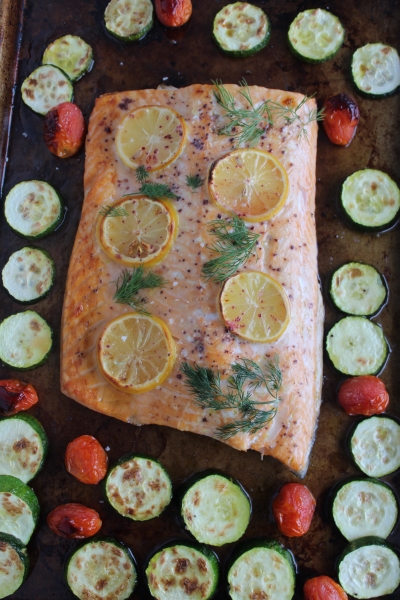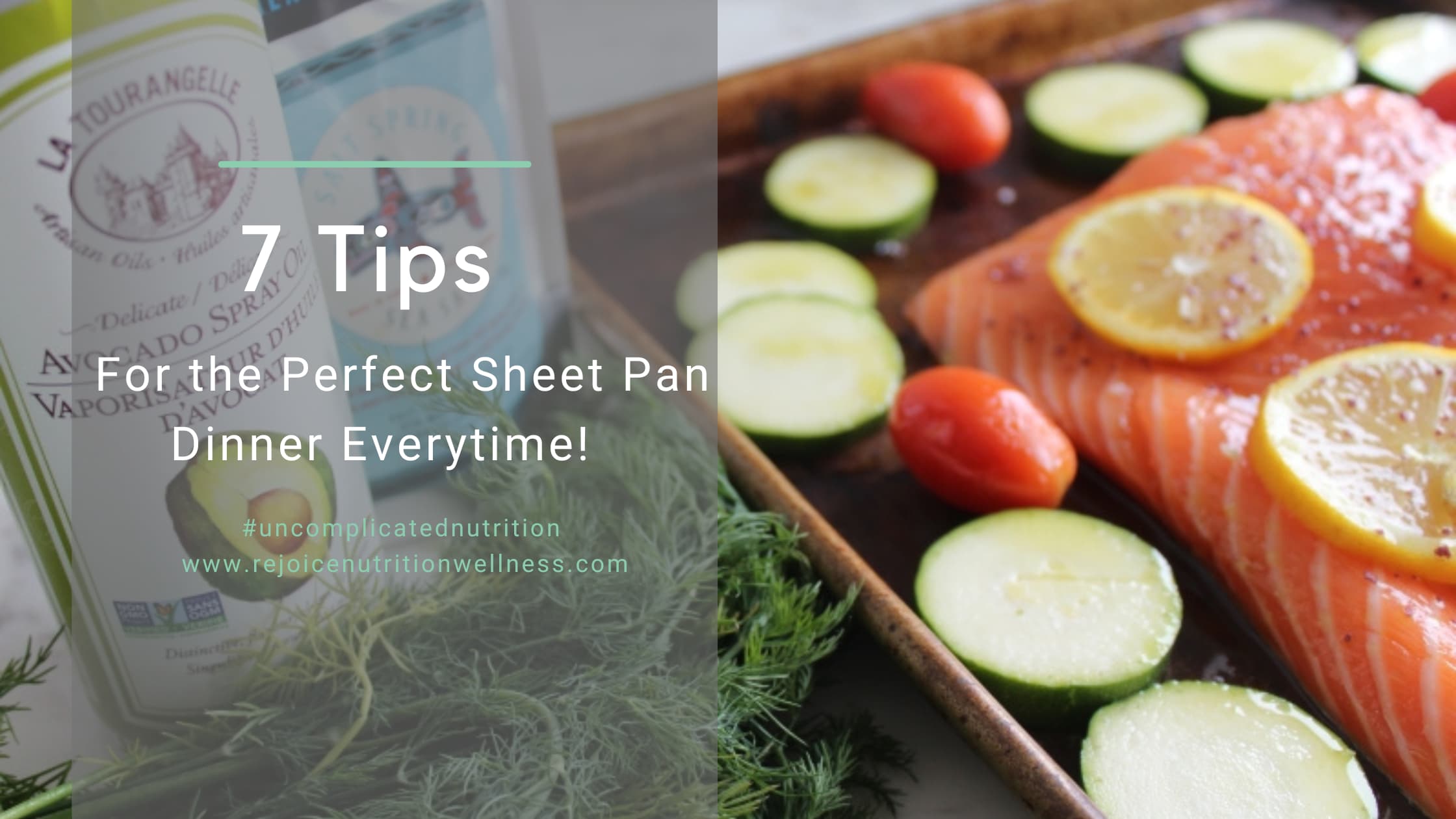Sheet Pan or “One-Pan” Dinners are an evolution of the one-pot meal. They are a great way to use the food you have in your home to make a quick and easy meal with little mess or fuss. Sheet Pan meals allow easy clean-up and will enable you to use up fresh or frozen food in the house to reduce food waste and be mindful of your food budget. For me, sheet pan meals are a great weeknight or tight-budget solution for any meal. The one critique I have heard about sheet pan meals is that it leaves the veggies mushy, soft, and overcooked, which actually means that there is too much crowding on the pan. If the veggies are layered on each other then the veggies will steam versus roast and will leave your veggies soft and feeling overcooked due to being overcrowded. Follow my 7 tips for the perfect sheet pan dinner every time!
1. The Right Pan is KEY!
Temperatures and times for sheet pan cooking are almost always specific to whats know as a “HALF-SHEET PAN”. This is a heavy-gauge bottom meal pan, it has a 1″ rim, and measures about 18 by 13″. It is thick enough to take the high heat without burning the bottom of the veggies (if your sheet pan meals come out with some burnt bottoms, then it’s your pan). The size allows for food to be well spread out so the veggies roast instead of steam. The great news about these pans is they are not expensive and are a multitasking pan so you will use it again and again. NOTE: be sure to not confuse a half-pan with a jellyroll pan, as they look the same but jellyroll pans are not meant to take higher temperatures and are smaller and flimsier than the half-sheets.
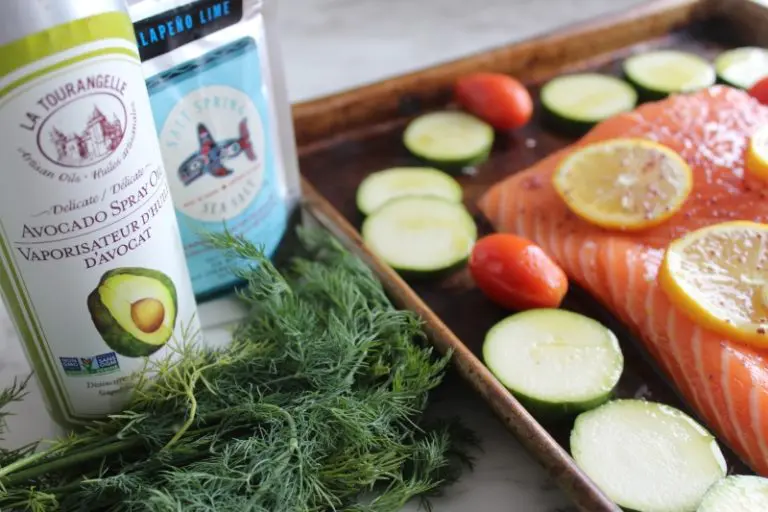
2. Set it Up for Easy Clean Up
Sheet Pan meals already set you up for easy clean-up. However, lining your pan with heady duty foil or cooking parchment paper based on your access and budget is another great way to make cleaning up dinner even easier.
3. Give them Some Room
As mentioned above, this is one of the most common mistakes when making a sheet pan meal. If you overcrowd the pan and the veggies are piled on top of each other the veggies below end up getting a steam which based on the veggies you are using can make them tasty mushy and too soft. It is best to spread them out so veggies are not overcrowded as you can see in the photo around the salmon. However, if space is an issue and you need to do some stacking be intentional with what goes where. For example, I would put the root veggies on the bottom (I.e carrots or potatoes), then put more delicate veggies like asparagus and tomatoes on top.This way the steam of the root veggies will help them cook faster to balance out the timing with the softer veggies on top.
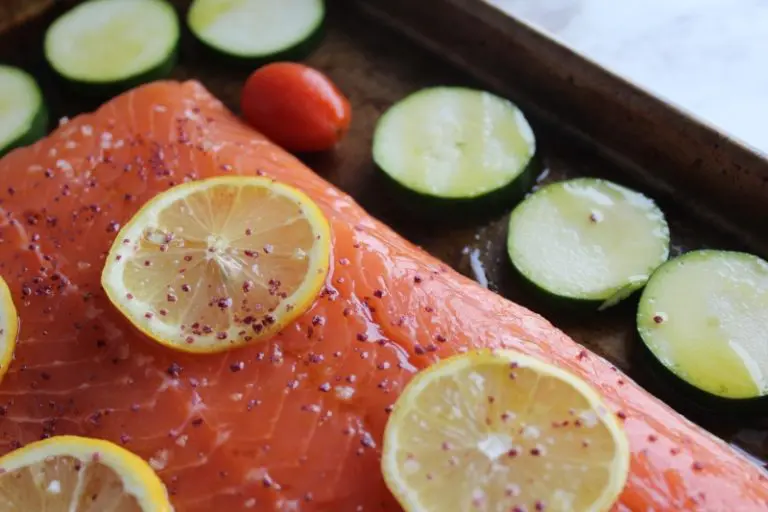
4. Split the Time
Most sheet pan recipes will give you the “total time” until the dish is done (i.e. 25 minutes cooking time). However, you can split the time up based on what you have on the pan. My one pan salmon dinner shown in the photos intentionally paired softer veggies like tomatoes and zucchini with the salmon because the “total cooking” time can be done by putting the entire pan in the oven once and pulling it out of the oven at the end of the cooking time for perfectly cooked fish and veggies within 10-15 min. However, if this recipe included potatoes the “total cooking time” would need to be set higher for the potatoes (i.e. 30 min) when the rest of the ingredients only need half the time. So the solution is to split the time.
You can roast the Hardy and denser veggies like potatoes and carrots for 15-20 minutes, then add the softer vegetables like beans, asparagus, tomatoes, and fast-cooking proteins like fish or tofu to the pan and pop the pan back in to finish cooking for the final 10-15 minutes. Another great example if chicken, potatoes, and green bean sheet pan meal with a total cooking time of 45 minutes. You can arrange potatoes and chicken and cook for 35 minutes, then when the timer goes off toss the green beans onto the pan and set the timer for the remaining 10 minutes. No extra time, but splitting the time for a perfect sheet pan meal based on what you choose to put on the sheet.
A final tip here is also to simply chop the denser longer cooking veggies into smaller pieces to cook faster!
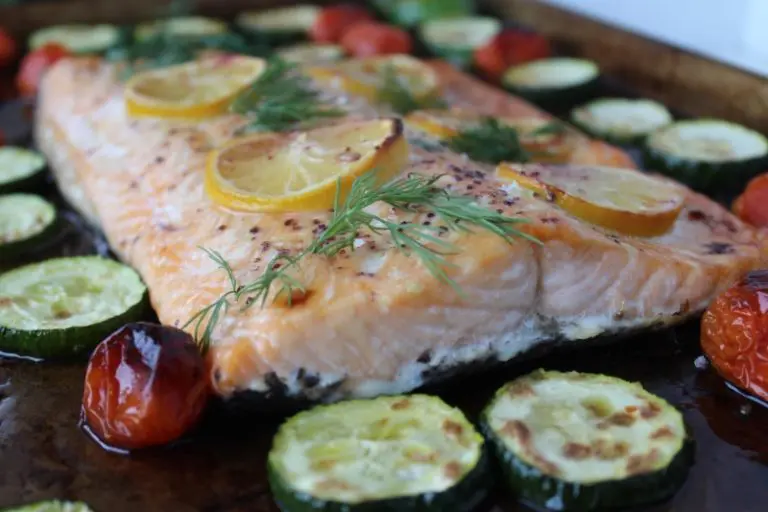
5.Lift Em Up
Sometimes in a home you have different taste and dietary needs. Maybe you love fish but your kids or parter does not! Leaving you needing to make 2 proteins. Instead of making 2 sheets you can use the wire rack to lift one protein from the other. For example if you want to bake breaded chicken fingers along with fish with veggies then a rack on your pan is a great solution. A wire rack onto the sheet pan can lift breaded chicken while keeping fish along with vegetables on the bottom. This will help your crisp breaded coating from getting soggy from moisture from the veg on the bottom of the pan.
6. Lube them Up
To ensure that your veggies don’t dry out you want to lube them up with some oil. This is a great way to add fats to your meal as well. I find placing my veggies and seasonings into a bowl and tossing them with oil first then layering them onto the pan gives them the best coat. However, if you want to keep the dirty dishes down you can toss the veggies in oil on the pan itself.
Choose a fat that has a high smoke/heating point. Avocado oil is 520F, Safflower oil is 510F, Coconut oil is 450F, Ghee or Butter is 450F, and Beef tallow has 400F. By choosing the right oil for the right temperatures you are able to better maintain the health benefits within the fat itself, and reduce inflammation from rancid oils.
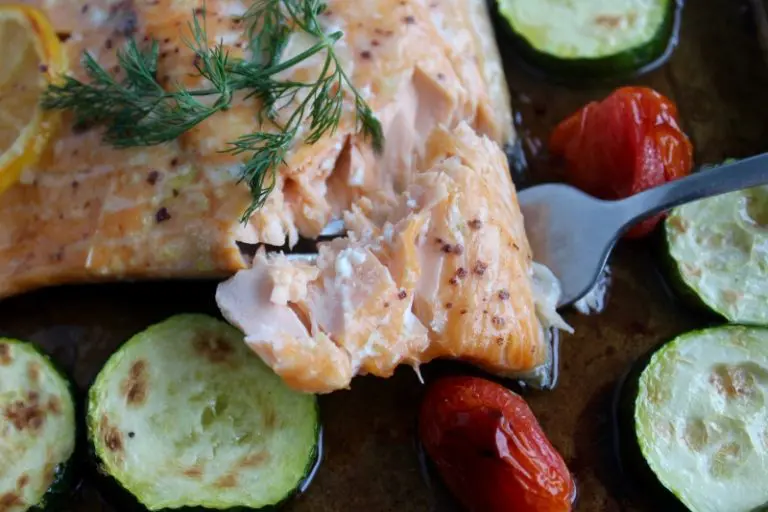
7. Boost the Flavor
Spice up your life and keep your meal times interesting by trying new spices and flavors. We can all fall into the same boring dinner routine with the same flavors and ingredients, so try new flavors to keep things interesting. You can get just a little bit of a new seasoning from the bulk section or bulk store for cents instead of paying for a whole jar of seasoning when you are not sure if you love it yet to be mindful of the budget.
Some ideas include:
- Squeeze fresh citrus juice or add zest from oranges, lemons, lime, or grapefruit onto veggies and protein
- Toss in some nuts or seeds like pecans, almonds, pine nuts, hemp seeds, brazil nuts, etc
- Fresh herbs can transform a dish! chop up and add parsley, oregano, basil, thyme, sage, etc
- Freshly grated roots like ginger, turmeric, wasabi, or horseradish can boost the flavor profile
- Add some heat to chiles either fresh or dried. Think cayenne, jalapenos, chipotles, or ancho powder
- Pantry items like balsamic or rice vinegar. maple syrup, mustard, or your favorite sauce.
- Try new seasoning blends like garam masala, Italian, greek, jerk, Chinese 5 spice, etc. I have a blog post for how to make 10 easy rubs and spices if you are looking to make your own and save money.
If you make a sheet pan meal and try any of these tips I would love to know how it came out. Post a comment below or share your photo on social media and tag @rejoicenutritionwellness
For some Sheet Pan Food Ideas check out,
